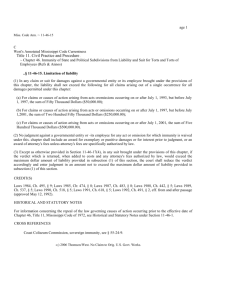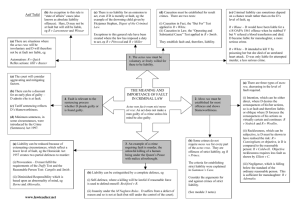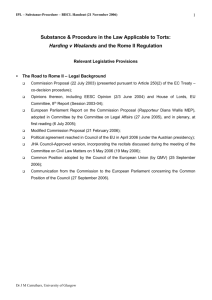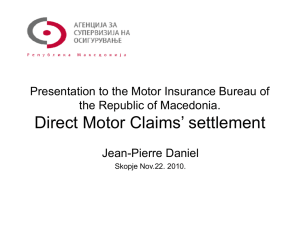joint liability review
advertisement
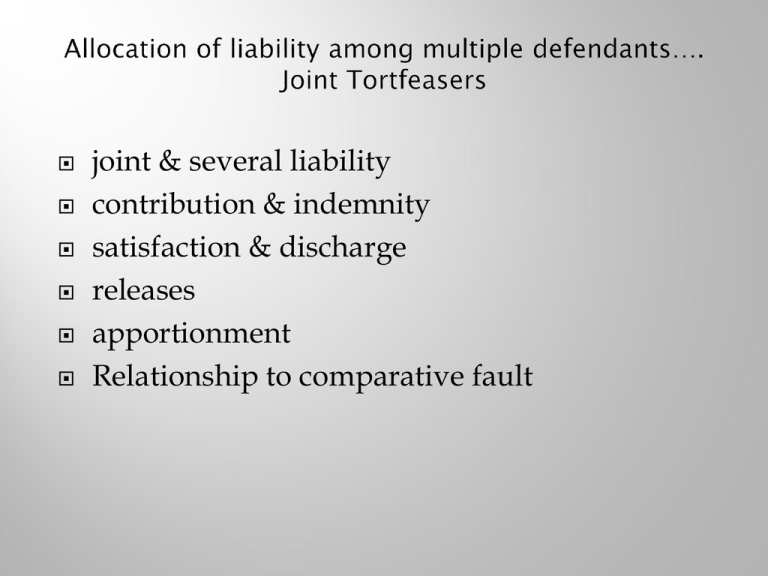
joint & several liability contribution & indemnity satisfaction & discharge releases apportionment Relationship to comparative fault • General rule of Joint & Several Liability? – • Each D is jointly liable with all other Ds for all damages and each D is also individually liable for full amount: P can get compensation from any one or all as group(rule favoring P’s full compensation) Basis for joint liability (when does it apply) – 1stDs act in concert to create “joint risk” (see note 5, p. 363) – 2nd Note 7: Failure to perform common or shared duty • e.g. elevator falls (landlord/ tenant/ repair co.)…may include vicarious liability relationships (e.g., partners) – 3rd Note 8: Independent acts of negligence combine to create indivisible injury (not capable of apportionment) distinguish from procedural “joinder” of parties and claims (see note 3, p. 362) Bierczynski v. Rogers Basis for Joint & Several Liability? • Assume: $100,000 in damages in this case means….what? If Race has no $? If ∏ hates Rodgers and is best bud with Race? • Contrast: from “apportionment” acting independently D1 breaks P’s leg, D2 breaks P’s nose… • • The evidence shows which D caused what damage…that is, the damages can reasonably be apportioned between them NB: the D’s act independently…if they act in concert? • • Comparative fault accounting for contributory negligence of P by reducing damages by percentage of fault If Jury must assess relative fault of P why not also for other defendants? – • Any effect on J & S liability? – – • D1: 60% fault, D2: 30% fault, P: 10% fault Arguments for and against eliminating J & S Key policy problem: Risk of missing or impecunious D Florida? figure it out based on statute • General Rule? – • • Recovery from any or all- but only one satisfaction of claim Bundt v. Embro What is the “one satisfaction” mean? Settlement? – Multiple judgments? – • • Partial Satisfaction- Note #4 -must credit other ∆’s Collateral Sources- Note # 4 • Common law rule: – • What is a “release”? – – • • Legal effect? Surrenders ∏’s claim Distinct from “satisfaction”? How is “covenant not to sue” different? – • Release one of J.T. releases all K’tual promise not to sue which does not technically release claim against D Modern approach Mary Carter Agreements • • • Common Law Rules on Contribution – Ds may seek contribution from other Ds who paid less than their share…which is? – Traditional Rule for dividing damages among joint ∆’s: if there are 4 ∆s & 100,000 judgments? • pro rata apportionment b/w Ds J & S who pays what to P versus Contribution how D’s divide up…between Ds What if a state eliminates J & S? Effect on contribution? What if ∆1 settles for $1000 but later Judgment against ∆2 for $100,000? Can ∆2 seek contribution from ∆1? If so, why would ∆1 settle? What if D1 settles for $100,000? Can he seek contributions for other non-settling Ds? • Knell v. Feltman: when can D seek contribution…? – what if P doesn’t sue D2? – C/L rule against Contribution among joint tortfeasors…intentional torts • Under Fla. Law?768.31 (2)(d) and (5)(b)? • Yellow Cab (immune D) Distinct from Contribution in that entire liability of D …is shifted to actual tortfeasor (or by K’tual promise) Why? Liability imposed by law/relationship e.g. vicarious, dangerous instrumentally, innocent partner

